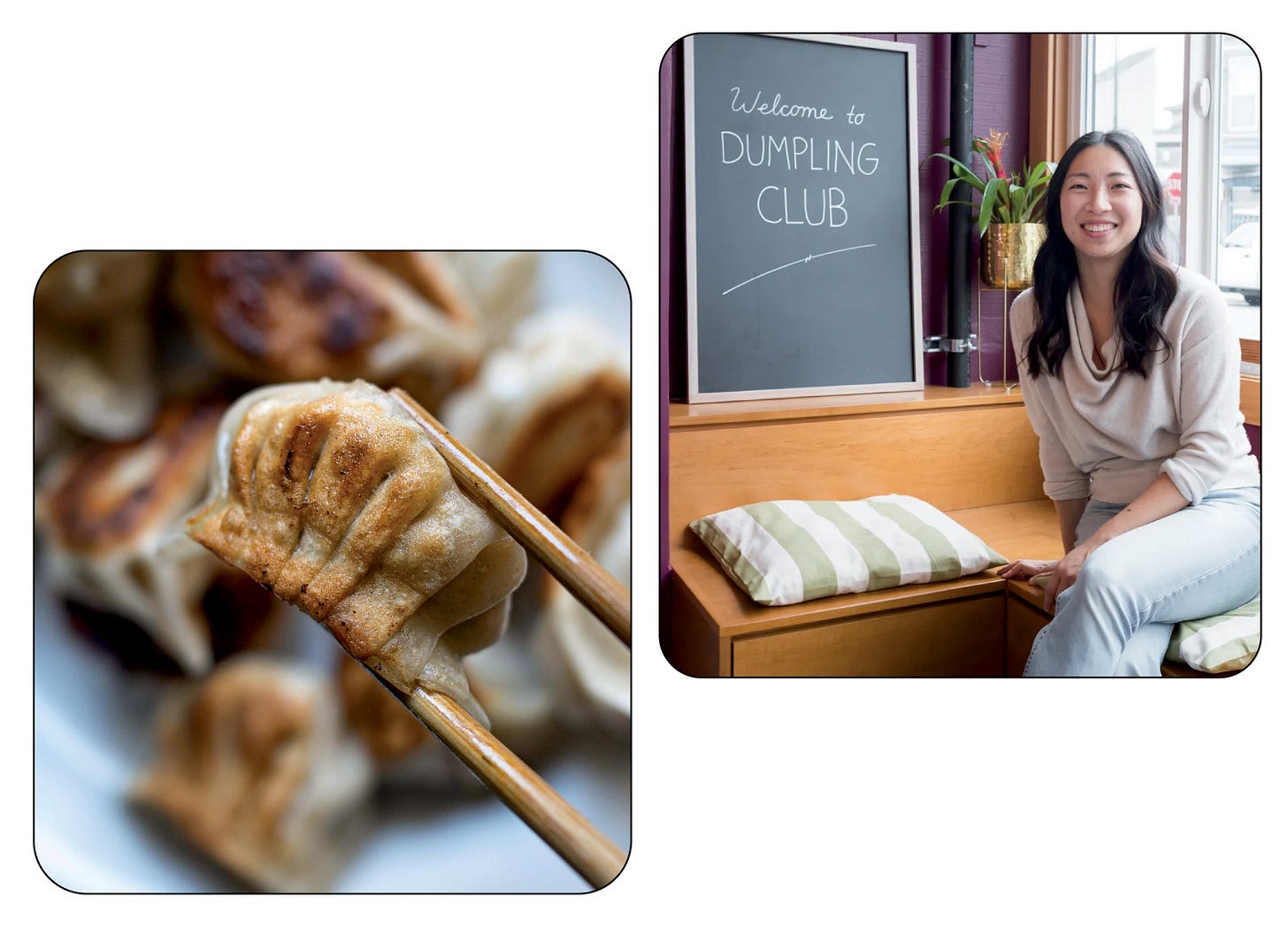So You Want To Start A Dumpling Business?
Dumpling makers from 16 businesses across the US share what keeps them—and their businesses—going. (A collaborative series in four parts!)
This is the first of a special four-part collaborative series between Leah Mennies of Above the Fold and Cathay Bi of Dumpling Club. We’ll be sharing one installment each week in July, across both our Substacks.
This series is excerpted from the second issue of the Above the Fold zine, which includes many more stories about dumpling culture across the US.
Leah and Cathay met in 2022, when Leah interviewed Cathay for the Above the Fold newsletter. At the time, we’d collaborated on a diagram depicting the hierarchy of Chinese food according to Cathay’s Yeye (a 100% biased opinion that ranked dumplings, naturally, at the very top). In early 2024, we reconnected: Leah was working on Issue 2 of the zine, and Cathay was reflecting on all the lessons learned from running Dumping Club.
We bonded over a shared motivation to provide readers with a frank portrayal of what it really takes to operate a dumpling business in the US today. Roughly 75 emails, a half-dozen Google Meets, and one large survey later, we amassed a rich trove of advice and insights, generously shared by 15 dumpling makers (plus Cathay!) based everywhere from California to Ohio, Maine, Oregon, Massachusetts, and more.
In this first installment, you’ll find Cathay’s opening essay about why she launched–and eventually closed–her dumpling business, as well as an introduction to the dumpling makers surveyed for this feature. Next week, we’ll share how dumpling makers select their business models and make funding decisions.
Enjoy!
—Leah and Cathay
In October 2019, I quit my job as a product manager at Google and started making dumplings full-time.
Starting a food business wasn’t exactly my first choice. I had drafted a list of maybe a dozen startup ideas, ranging from a makeup bottle recycling program to a new social network built specifically for women, and somewhere on the list I had written “a better frozen dumpling”. As I went around pitching the ideas to friends and acquaintances, I kept hearing the same thing: “I want to be on the cap table for your dumpling company.” (Note: you know you work in Silicon Valley when people use ‘cap table’ in a sentence. )
Soon, I became enamored with the idea of creating a truly delicious, high-quality line of frozen dumplings. Jiaozi (the Chinese word for dumplings) are deeply personal to me: Both of my grandfathers were originally from Shandong, a northern province in China that’s known for shuijiao (boiled dumplings) and I grew up learning how to make them alongside my Yeye, who considered shuijiao to be the pinnacle of Chinese cuisine. For me, dumplings evoke a sense of community and belonging, a dish that is as much about the process of making them as it is about the end product.
But beyond my personal affinity, there are plenty of arguments for why dumplings are the perfect food. They consist of a perfect harmony of proteins and vegetables wrapped in a neat carbohydrate parcel. You can fill them with absolutely anything–pork, chicken, fish, tofu, cheese, an endless variety of vegetables. Kids love them because they are easy to hold and come with a dipping sauce. They taste just about as fresh from the freezer as they do when they are first made, which makes them easy to prepare in advance for a restaurant or sell to customers to take home. By November, I took the plunge and started Dumpling Club: a community-driven, ingredient-focused dumpling company which I ran out of a kitchen in San Francisco located just a few blocks from where I lived with my husband and two kids.
Four years later, what I thought would be an easy lifestyle business had turned into a marathon of pivoting from one business model to the next in attempts to make the math work while still preserving the integrity and quality of my products. During the pandemic, I ran a weekly delivery service that rotated through upwards of 40 different dumpling flavors and sides each week. I held corporate team- building events where I taught MBA interns how to pleat. I started an Asian cooking class series on Sundays featuring various friends as guest chefs. I bought a brick-and-mortar storefront (pictured), opened a dining room with cafe service, and outfitted the front of the shop with a retail space featuring mostly local Asian American artisans and food purveyors.
There was a lot of money coming in and a lot of money going right back out. I thought diversifying my revenue streams would make my company more resilient, but in doing so, I saddled myself with the costs of running several—at one point, seven!—very different business models. Choosing where to focus my energy was difficult, because it wasn’t clear which model was the best—the margins were pretty slim all around. Eventually I had too many balls in the air and the whole enterprise came crashing down. I closed Dumpling Club in October 2023.
Despite being a bit bruised from my experience, my enthusiasm for dumplings hasn’t waned. I still believe they’re a very special food with so much potential and as I look around the country, I can see a lot of entrepreneurs agree with me. In the spring of 2024, myself and Above the Fold connected with the owners of 15 fellow dumpling businesses across the country and through a series of interviews and surveys, put together a picture of what it takes to operate a dumpling business in the United States right now.

Many owners cited similar challenges: the complexities of cold-holding and cold-shipping frozen foods, the laboriousness of production (even once you add a machine into the mix), the rules and regulations and red-tape hurdles to overcome. All agreed that starting out is relatively easy and scaling is monumentally difficult. There is very little money in everyone’s pockets right now. And yet, we dumpling makers persist.
What I hope you take away from this feature is not only the immense challenge these businesses face, but the palpable optimism and love for the product that keeps them going (and customers returning). For any budding dumpling entrepreneurs, there’s lots of sound advice–insights I would have loved to have when I first started out. Happy reading! —Cathay Bi, Dumpling Club
Like what you read? Subscribe to Above the Fold and Dumpling Club for more! Next week: How dumpling makers navigate crafting their business model + make funding decisions.
*Note: Interviews and surveys were conducted between April and July of 2024. Information is accurate as of that timeframe; in the world of dumplings and business things are, of course, subject to change.







